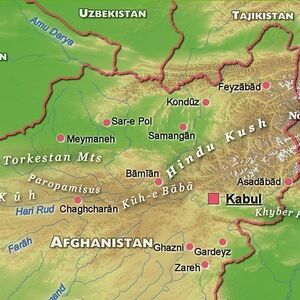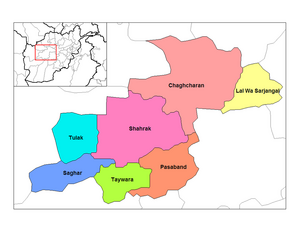Murghab
| Author:Laxman Burdak, IFS (R) |


Murghab (Hindi: मुर्गाब, Persian ولسوالی مرغاب) is a district located in Ghor Province, Afghanistan, created on 26 November 2019.
Variants
- Marghab
- Marghab River
- Persian/Pashto: مرغاب, Morqâb
- Anciently name Margiana
- Ancient Greek: Μαργιανή, Margianḗ
- Margiane (Pliny.vi.18)
- Moorghab
- Mouru (मोउरु): Sanskrit name Mriga (मृग) or Marva (मर्व), Greek Margiana.[1] In the Avesta and Margu in the Achemanian inscriptions, Margiana for the Greeks is the region identified with Turkmenistan having medieval times famous city Merv. N L Dey identified it with Sanskrit word ‘Mrga’ which name, according to him, has survived in Murg-Ab, the river of Merv. The whole region of Margiana lies in a fertile oasis between the Karakuram desert and the Kopet Mountains.
- Murg-Ab
- Murgab
Jat Gotras Namesake
- Mor = Morqâb = Margiane Pliny.vi.18</ref>
Geography
Shorabak area serves as the district center. The district encompasses 32 villages and around 19,000 people, Marghab District has approximately 40000 inhabitants and is mainly populated by Tajiks.[2] Sparf is the most populous area of Marghab district.
Most of the population live in the valley of the Marghab River.
Marghab River
The Marghab River (Persian/Pashto: مرغاب, Morqâb), anciently the Margiana (Ancient Greek: Μαργιανή, Margianḗ), is an 850-kilometre long river in Central Asia. It rises in the Paropamisus Mountains (Selseleh-ye Safīd Kūh) in Ghor Province, flows through the Marghab District in central Afghanistan, then runs northwest towards the Bala Murghab. Reaching the oasis of Mary in the Karakum Desert of Turkmenistan, the Marghab debouches into the Karakum Canal, a diversion of water from the Amu Darya. The catchment area of the Marghab is estimated at 46,880 square kilometres.[3]
History
Mention by Pliny
Pliny[4] mentions Nations situated around the Hyrcanian Sea....Next comes the district of Margiane,5 so remarkable for its sunny climate. It is the only spot in all these regions that produces the vine, being shut in on every side by verdant and refreshing hills. This district is fifteen hundred stadia in circumference, but is rendered remarkably difficult of access by sandy deserts, which extend a distance of one hundred and twenty miles: it lies opposite to the country of Parthia, and in it Alexander founded the city of Alexandria. This place having been destroyed by the barbarians, Antiochus,6 the son of Seleucus, rebuilt it on the same site as a Syrian city.7 For, seeing that it was watered by the Margus,8 which passes through it, and is afterwards divided into a number of streams for the irrigation of the district of Zothale, he restored it, but preferred giving it the name of Antiochia.9
5 This district occupied the southern part of modern Khiva, the southwestern part of Bokhara, and the north-eastern part of Khorassan. This province of the ancient Persian empire received its name from the river Margus, now the Moorghab. It first became known to the Greeks by the expeditions of Alexander and Antiochus I.
6 Antiochus Soter, the son of Seleucus Nicator.
7 The meaning of this, which has caused great diversity of opinion among the Commentators, seems to be, that on rebuilding it, he preferred giving it a name borne by several cities in Syria, and given to them in honour of kings of that country. To this he appears to have been prompted by a supposed resemblance which its site on the Margus bore to that of Antiochia on the Orontes.
8 The modern Moorghab; it loses itself in the sands of Khiva.
9 Its remains are supposed to be those of an ancient city, still to be seen at a spot called Merv, on the river Moorghab.
Jat History
Hukum Singh Panwar (Pauria)[5] writes - Continuing our quest for more variants of the word Jat as an ethnic term, we now turn to Central Asiatic countries and their chronicles. In the countries of the Oxus valley we come across the word Jatah or Jeteh75 , Zutt or Az-Zutt76 , Jith or Git77 during medieval and early medieval times, now only as names ot various places including villages, towns, canals, rivers and mountains but also those of the Jat people who inhabited them after their deportation78from India. From classical historians and geographers of the first century BC as well as from those of first century A.D. have come down to us variants like Xanthii or Zanthii or Xandii79 Iatii or Iatii80, used for the people living on the banks of the Oxus between Bactria,
The Jats:Their Origin, Antiquity and Migrations: End of page 344
Hyrkania and Khorasmia81. Xuthi or Zuthi 82 for those who occupied Karamanian desert and Drangiana 83, One scholar84 suggests that those people gave their name as Zatale or Zothale to the irrigation channel from the Margus rive. All these terms are said85 to be variants of the term Jat with their "parental house on the Oxus" and their original seat or colony in Sindh as well as "on the Margus (Zotale or Zothale) river". This reference definitely indicates that the Jats were spread over the region bounded by Indus in the east and the Oxus in the West in Central Asia. This learned scholar seems perplexed in deciding the original habitat of the Jats in spite of the fact that earlier scholars like Pliny, Diodorus Siculus and Megasthenese had claimed that contemporary Indians were indigenous.
External links
References
- ↑ परोपकारी, अप्रेल प्रथम 2019, s.n. 3, p.6
- ↑ Khwaja Basir Fitri (26 November 2019). "Senate approves Marghab district creation in Ghor". pajhwok.com. Pajhwok Afghan News.
- ↑ "Surface water resources in North Afghanistan".
- ↑ Natural History by Pliny Book VI/Chapter 18
- ↑ The Jats:Their Origin, Antiquity and Migrations/Jat-Its variants,pp.344-345
Back to Jat Places in Afghanistan

